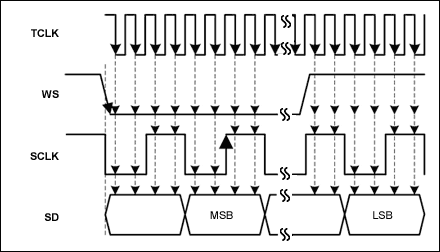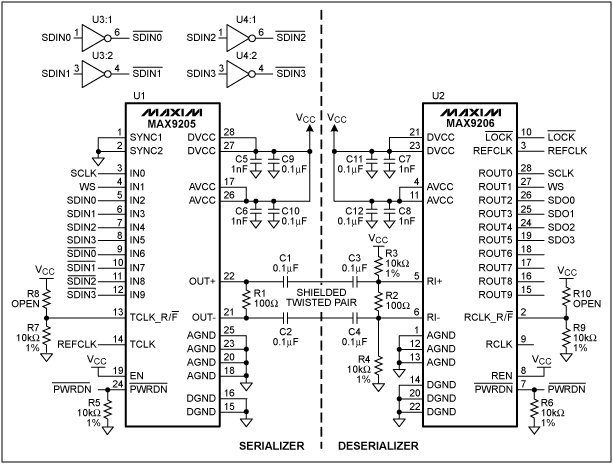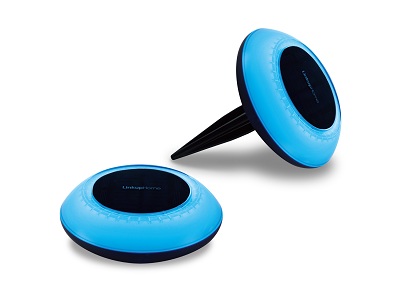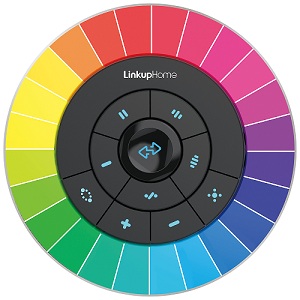IntroducTIonLow-voltage differenTIal signaling—the most effecTIve interface for in-vehicle digital video routing—can also be used as a low-cost solution to transmit digital audio data streams.¹ This application note details how to use the MAX9205 / MAX9206 10-bit LVDS serializer / deserializer (SerDes) ICs for transmitting up to four I²S audio data streams across STP wiring. Refer to the MAX9205 / MAX9206 data sheets for detailed information on these ICs.
The LVDS Serializer AdvantageSince each time an audio signal is converted between analog and digital domains the sound quality is degraded, it is important to keep audio data in digital form when possible in order to provide the best sound quality. The MOST® bus is designed for in-vehicle audio data transmission but is expensive to implement and overkill for most applications. For consumer audio equipment, S / PDIF is commonly used to transmit compressed audio data from one piece of audio equipment to another. However, S / PDIF does not have the bandwidth to transmit 5.1 or 7.1 digital audio in an uncompressed format and lacks a proven, robust physical layer for automotive applications.
Transmitting digital audio data using LVDS provides a robust, low-cost, high-bandwidth interface solution that can be easily added to existing hardware without impacting system resources. Digital audio data in the form of I²S streams, which are already available, can be transmitted to a different location in a vehicle with virtually no software overhead. By keeping the audio data in digital form, multiple ADCs, DACs, and wires can be eliminated from the system, thereby freeing up cost and board space for other features.
LVDS is already used to route video data from cameras, DVD players, and navigation systems to various displays in the vehicle. Its low signal amplitude and differential structure allow LVDS to transmit high-bandwidth data with low electromagnetic radiation.
The MAX9205 / MAX9206 SolutionThe MAX9205 is designed to transmit 10-bit parallel data from a single reference clock. To transmit the I²S signals SCLK, WS, and SDA0–3 as data, we need a reference clock that is synchronous to SCLK and at least two times the frequency. The specified reference clock frequency range for the MAX9205 is between 16MHz and 40MHz. However, the IC will lock onto a reference clock as low as 10MHz. This allows us to use the commonly available clock frequency of 12.28MHz.
Signals that leave a module in the wiring harness must be robust to withstand the harsh automotive environment and failure conditions. The LVDS bus needs to be AC-coupled to prevent damage if high-voltage short conditions occur. Since the MAX9205 does not automatically DC- balance the outgoing signal we must make sure that the data being transmitted is in fact DC-balanced. Since we are using no more than six of the ten available inputs we can use the remaining four inputs to DC-balance the transmitted data. The SCLK and WS signals are symmetrical signals so we only need to invert the random signals SDA0–3 and feed them into the unused inputs to ensure that the number of ones and zeros are equal for every 2-channel I²S packet transmitted.
To meet the setup and hold times for the MAX9205 and prevent excess jitter at the output of the MAX9206 deserializer, the I²S signals should be sampled when they are not changing state. Connect TCLK_R / F to GND to enable the MAX9205 to sample the inputs on the falling edge of the reference clock (TCLK). This assumes that the rising edge of TCLK corresponds to when SCLK changes state. If this is different than your configuration, make the appropriate adjustment to TCLK_R / F to ensure that the setup and hold times for the inputs are met. See Figure 1 below for the proper sampling of the I²S input signals.

Figure 1. Sampling of I²S input signals.
Figure 2 illustrates the application schematic diagram.

Figure 2. Schematic diagram for using the MAX9205 / MAX9206 to transmit I²S audio data.
The left side of the schematic (labeled "Serializer") contains the circuit needed to serialize and transmit the LVDS audio data streams. Table 1 contains a list of components and signal descriptions for the serializer circuit.
Table 1. Component and Signal List for the Serializer Side
| DESIGNATION | QTY | DESCRIPTION |
| R1 | 1 | 100Ω ± 1% Surface-mount resistor |
| R5, R7 | 2 | 10kΩ ± 1% Surface-mount resistors |
| R8 | 1 | Unpopulated. Move R7 here to sample I²S signals on the rising edge of REFCLK. |
| C1, C2 | 2 | 0.1µF 25V ± 5% Surface-mount ceramic capacitors |
| C5, C6 | 2 | 1nF 16V ± 10% Surface-mount ceramic capacitors |
| C9, C10 | 2 | 0.1µF 25V ± 10% Surface-mount ceramic capacitors |
| U1 | 1 | MAX9205EAI 10-Bit LVDS Serializer |
| U3, U4 | 2 | Dual inverter—ON Semi NL27WZ04DFT2G |
| SCLK | — | I²S serial clock |
| WS | — | I²S word select or left / right channel select |
| SDIN0–3 | — | I²S serial data stream |
| Active-low SDIN0–3 | — | Inverted I²S serial data stream input. This DC-balances the LVDS data stream to allow AC-coupling of the output. If AC-coupling is not necessary, then these signals can be tied to GND or used for control signals. |
| REFCLK | — | Reference clock. This reference clock must be at least two times the frequency and synchronous to SCLK. With a 48kHz I²S sample rate this clock must be at least four times SCLK. The inputs IN0–9 will be sampled on the falling edge of REFCLK with R8 populated and R7 unpopulated. |
| Active-low PWRDN | — | Power-down logic input. Pull down to put the part into shutdown mode. |
The right side of the schematic (labeled "Deserializer") contains the circuit needed to receive and deserialize the LVDS audio data streams. Table 2 contains a list of components and signal descriptions for the deserializer circuit.
Table 2. Component and Signal List for the Deserializer Side
| DESIGNATION | QTY | DESCRIPTION |
| R2 | 1 | 100Ω ± 1% Surface-mount resistors |
| R3, R4, R6 | 2 | 10kΩ ± 1% Surface-mount resistors |
| R9 | 1 | 10kΩ ± 1% Surface-mount resistor. When populated ROUT_ is strobed out on the falling edge of REFCLK. |
| R10 | 1 | Unpopulated. Move R9 here to strobe ROUT_ out on the rising edge of REFCLK. |
| C3, C4 | 2 | 0.1µF 25V ± 5% Surface-mount ceramic capacitors |
| C7, C8 | 2 | 1nF 16V ± 10% Surface-mount ceramic capacitors |
| C11, C12 | 2 | 0.1µF 25V ± 10% Surface-mount ceramic capacitors |
| U1 | 1 | MAX9205EAI 10-Bit LVDS Serializer |
| U2 | 1 | MAX9206EAI 10-Bit LVDS Deserializer |
| U3, U4 | 2 | Dual inverter—ON Semi NL27WZ04DFT2G |
| SCLK | — | I²S serial clock |
| WS | — | I²S word select or left / right channel select |
| SDO0–3 | — | I²S serial data stream |
| Active-low LOCK | — | Lock indicator. Active-low LOCK goes low when the PLL has achieved frequency and phase lock to the serial input, and when the framing bits have been identified. |
| REFCLK | — | Reference clock. This clock must be within ± 500ppm of the MAX9205 reference clock frequency. |
| Active-low PWRDN | — | Power-down logic input. Pull down to put the part into shutdown mode. |
ConclusionLVDS—the most effective interface for in-vehicle digital video routing—is also an effective interface for transmitting audio data. The MAX9205 / MAX9206 LVDS serializer / deserializer ICs provide a simple, low-cost solution for transmitting multiple I²S audio streams between two points in a vehicle. Maxim's next generation of LVDS products will continue to improve and support sending control and data across the same STP wire, thereby eliminating the need for an extra control interface.
¹For an application note that details the advantages of LVDS for digital video transmission in automotive applications, refer to Application Note 4019: LVDS Offers Robust Video Interface for Automotive Applications.
MOST is a registered trademark of MOST Corp.
Smart solar outdoor light with both lighting and RGB colorful lighting, can be charged with USB and solar panel. Once it has sunlight, the solar panel can be automatically charged , the charging way is very environmentally friendly. We added a USB charging way so that it can be quickly charged via the USB cable in cloudy day or rainy day.
The outdoor light is solar-sensing, it will automatically turns off when in the bright enviroment, then begin to charge by solar. When the night comes, it will automatically turn on in the dark. Waterproof IP65 makes users no need to worry when using in the rainy day.
Equipped with a detachable plastic sticker, it can be used to decorate the lawn, garden, beach... After removing the plastic sticker, it can be placed on the table as an ambient light. They will be stars fall into your garden, twinkle in the dark and go off in the day. Automatic cycle colorful mode makes parties begin at anytime and anywhere.

Our LED products can meet global quality standards and pass European testing by TUV Rheinland. Bulbs have certifications such as EMC, RED, LVD, ROHS, REACH, ERP and FCC.
With the exclusive designed 2.4G remote controller, get you off the switch and turn on / off the lights anywhere, one remote controller can set 4 groups, each group is recommended to match up 8pcs bulbs, one remote controller can max control 32 bulbs. This remote controller is suitable for all 2.4G versions of RGBW products under [linkuphome".
The remote control uses colorful touch buttons, the color touch buttons are comfortable and sensitive. The remote controller has the functions of grouping, lighting, brightness adjustment, color light automatic cycle mode, three cycle speeds can be choosed. The wireless control distance is around 20 meters. Low power consumption makes the remote controller only need 4pcs AA batteries, but can be used for two years.

Description: RGB Outdoor Solar Lamp with 2.4G Control
Product Model No. C2
Product dimension: 155mm *165mm
Material: ABS+PC
Lamp Color: 8pcs RGB lamp beads+4pcs Warm White lamp beads
Lamp Current: 15-20mA
Power: 0.5W (15LM)
Battery Capacity: 1000mA (Li battery included)
Battery Voltage: 3.7V
Battery Duration: 9h(by USB charge for 1.5h) , 5h(by solar panel for whole sunny day)
Solar Panel: Monocrystalline silicon
Solar Panel Voltage: 6V
Solar Panel Output: 130mA
Waterproof Level: IP65
Control Qty: 1-32pcs
Packing: color box
Warranty: 1 Year
Charge Mode: Solar Panel and USB
Control Distance: 20m
Color box size: 22.2*20.6*5cm
G.W. of Unit: 0.55kg
N.W. of Unit: 0.34kg
Certification: CE(EMC,RED) ROHS,IP65,FCC
Description: 2.4GRF Wireless RGB Remote Controller
Product Model No.: R1
Product dimension: 105mm *33mm,
Product Net Weight: 150g
Material: ABS
Battery: 4*AA Battery (not included)
Working Voltage: 6V
Standby Power: 3 mW
Frequency Band: 2400-2483.5MHz/2.4GHz
Control Distance: 20m
Control bulb qty: 1-32 pcs
Packing: color box
Warranty: 1 Year
Color box size: 16.7*14.7*4.5cm
G.W. of Unit: 0.22kg
N.W. of Unit: 0.15kg
Outdoor Lamp With Remote Control
Outdoor Lamp With Remote Control,Remote Control Outdoor Lamp,Waterproof Outdoor Lamp,Remote Control Outdoor Colorful Lamp
Ningbo Homey Photoelectric Technology. Co., Ltd , https://www.linkuphome.com